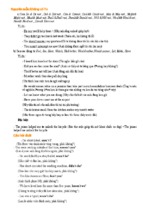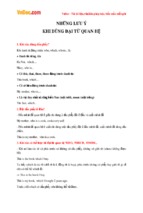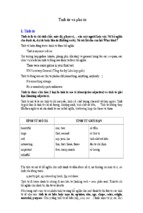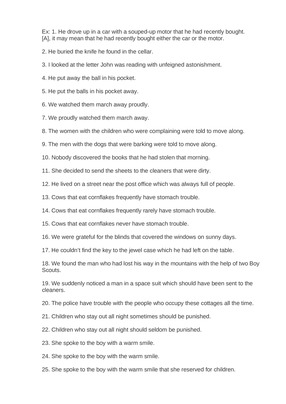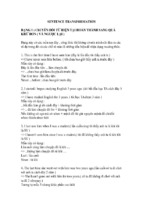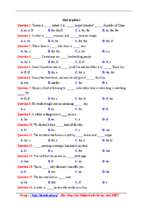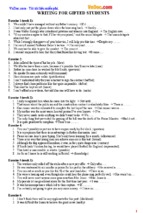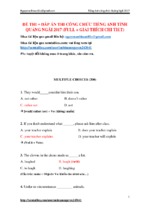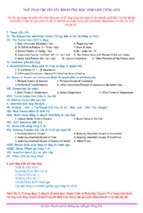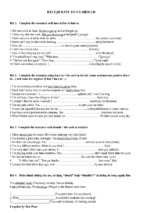TE
AM
FL
Y
Praise for Business Etiquette
“This book teaches individuals how to represent their
companies, their products, and themselves with confidence,
polish, warmth, and professionalism.”
—John Daw, Vice President of Field Sales,
Marriott Lodging
“Gets right to the heart of the matter. An invaluable
resource for anyone whose work involves interaction with
others—and that’s just about all of us.”
—Brandon Toropov, author, The Complete Idiot’s
Guide to Getting Along with Difficult People
“Helps individuals to determine which behaviors to
maintain and which to modify in order to achieve confidence and, ultimately, success in the world of business.”
—Robyn M. Hildal, Ed. D., Human Resources
Manager, The E.W. Scripps Company
“Up-to-date and easy to read—a big departure from
most business etiquette books.”
—Sheila Casserly, President, Celebrity Focus
“Assists individuals in enhancing their understanding
of the ‘perception impact.’ ”
—William H. Bagley, Regional Director
of Human Resources,
Deloitte & Touche
SECOND E D I T I O N
BUSINESS
ETIQUETTE
SECOND E D I T I O N
BUSINESS
ETIQUETTE
101 Ways
to
Conduct Business
with
Charm & Savvy
ANN MARIE SABATH
The Career Press, Inc.
Franklin Lakes, NJ
Copyright © 2002 by Ann Marie Sabath
All rights reserved under the Pan-American and International
Copyright Conventions. This book may not be reproduced, in
whole or in part, in any form or by any means electronic or mechanical, including photocopying, recording, or by any information storage and retrieval system now known or hereafter
invented, without written permission from the publisher, The
Career Press.
BUSINESS ETIQUETTE, 2ND EDITION
TYPESET BY STACEY A. FARKAS
Cover design by Design Concept
Printed in the U.S.A. by Book-mart Press
To order this title, please call toll-free 1-800-CAREER-1
(NJ and Canada: 201-848-0310) to order using Visa or MasterCard,
or for further information on books from Career Press.
The Career Press, Inc., 3 Tice Road, PO Box 687,
Franklin Lakes, NJ 07417
www.careerpress.com
Library of Congress Cataloging-in-Publication Data
Sabath, Ann Marie.
Business etiquette : 101 ways to conduct business with charm and savvy / by
Ann Marie Sabath.—2nd ed.
p. cm.
Bookz ISBN 1-56414-614-6 (paper)
1. Business etiquette. I. Title.
HF5389 .S228 2002
395.5’2—dc21
2002017535
Acknowledgments
My acknowledgments go to...
That man of vision, my publisher, Ron Fry.
My parents, Mary and Camille Sabath, whose actions
taught me both the work ethic and the importance of
hospitality.
My Aunt Nell who showed me that “What you do is important, however, the way you do it is even more important.”
My children, Scott and Amber, who have been my “test
cases” for grooming the “McManners” Generation.
My dearest Thomas Byron who continues to be my
sounding board regarding what is “appropriate.”
My colleague, Suzy, whose attention to detail exemplifies the way all organizations should conduct business.
Elin Woodger, who helped with text development and
editing.
My literary agent, Brandon Toropov, who made this
book a reality.
Our client companies who have requested us to reinforce to their teams the importance of doing business with
charm and savvy.
My Cincinnati Downtowner newspaper readers who
have submitted questions about their own business courtesy dilemmas.
Our many business etiquette hotline callers who allow us
to assist them in overcoming their “moments of hesitation.”
Our certification graduates who assist our organization
in preparing present and future business leaders to live by
“The Golden Rule.”
Contents
Introduction
Why You Need This Book ................................ 11
Chapter 1
Opening Moves: Making Initial ........................ 21
Encounters Work
Chapter 2
Business Dress 101: Handling Attire ................ 33
Problems in the Workplace
Chapter 3
Correspondence: Putting It Down in ............... 45
Black and White
Chapter 4
Sound Advice: Making the Right ...................... 65
Phone Impression
Chapter 5
Cubicle Protocol and Time Management: ........ 91
Functioning Well in the Office
Chapter 6
Meetings: Getting It All Together .................. 107
Chapter 7
VIPs: Dealing With Key Decision-Makers ...... 117
Chapter 8
Unfamiliar Settings: Handling ........................ 125
Social Situations
Chapter 9
Off the Beaten Path: Coping .......................... 135
With Challenges
AM
FL
Y
Chapter 10
Common Questions ....................................... 149
Appendix
International Etiquette ................................... 159
Bibliography ...................................................... 177
TE
Index ................................................................. 181
About the Author .............................................. 187
Introduction
11
Introduction
Why You Need
This Book
hen this book first came out in 1998, electronic
and wireless communication technology was, in
most settings, an occasional business tool at
best. Today, it’s the way we do business.
In 1998, cell phones were still called “mobile phones,”
and they were usually found in vehicles; today, they are
personal accessories that leave us feeling unprepared when
we forget them or misplace them. In 1998, e-mail was something you checked once in a while, or perhaps two or three
times a day if you were really compulsive. Nowadays, people
spend the entire workday sending and receiving e-mail, either at work or via a “smart” phone, and e-mail has all but
replaced “snail mail” as the primary means of written communication. In 1998, voice-mail systems were attached to
office and home phone lines rather than to cell phones;
W
11
12
Business Etiquette
they served as a backup means of communication. These
days, voice mail seems to be the main vehicle by which we
hear our customers, clients, and (for the ever-larger groups
of people who work at home), even our coworkers.
There have been other changes, as well. For instance:
Because face-to-face contact seems, for many
workers, to have become rarer and rarer, there’s
a higher rate of what I call “minglephobia”—an
apprehension of interacting with business contacts in informal social settings.
Today, some business people travel abroad
about as often as they fly from coast to coast.
As a result, questions of sensitivity to international customs and cultures have taken on
greater importance than ever.
The “business casual” style of office attire—
which many organizations offered as a perk to
employees—has, in many offices, morphed
into “business sloppy.” As this book goes to
press, there is a renewed emphasis on a new
style of business attire—“business ready”—
that may be the new standard for 21st-century
business dress policies.
Let’s face it—proper behavior in business settings can
be a scary topic. Being unsure of what move should come
next in a work-related situation is often quite unnerving.
When we’re scared, we don’t think very well. That can make
successful interaction with professional contacts seem almost impossible.
Like most of us, you’ve no doubt asked yourself plenty
of questions about conduct in the workplace, questions that
don’t seem to have easy answers:
Introduction
13
“What, exactly, am I supposed to wear on
dress-down day?”
“How do I handle people who come across
too strong during meetings?”
“What’s the best way to compose an e-mail
message to my most important prospective
client?”
“When I’m conducting business in another
country, what should I say—or avoid
saying—to my host?”
These are the kinds of questions that can keep people
up at night. I know, because I work every day with professionals who’ve lost sleep over matters of business behavior—
people who are eager, as you are, to learn how to conduct
business with charm and savvy. Through my business, At
Ease, Inc., I provide business protocol services and training through live seminars, videos, print media, and a telephone hotline service. I’ve trained thousands of individuals
and have worked with such organizations as Fidelity Investments, Procter & Gamble, Cap Gemini Ernst & Young,
United Brands, the Huffy Corporation, Showtime Network,
Inc., Saks Fifth Avenue, SmithKline Beecham, BP America,
Paychex, MCI Telecommunications, the Marriott International, and Deloitte & Touche. I’ve also worked with countless small businesses in addressing the same etiquette and
protocol questions that trouble representatives of the bigger companies.
How did I get started in my business? After graduating
from college and doing some experimenting in the work
world, I began to watch what people were doing to get ahead
in their organizations. I realized that the ones who knew
14
Business Etiquette
how to make the best impression and how to make others
feel comfortable in social situations were the ones who often got a leg up on the competition. So about 15 years ago,
I started taking some notes and eventually started a new
company. My aim was to help companies get the “sand”
out of their employees’ social “gears” and, as a result, to
increase their bottom lines.
Guess what? It worked!
Who is this book for?
Business Etiquette: 101 Ways to Conduct Business with
Charm and Savvy is for you—whether you’ve just landed an
entry-level office job, operate on the front lines with people
who use your company’s product or service, run your own
business, or hold any other position that involves maintaining business relationships with others. Whether you work
for a multinational corporation, a local print shop, or a oneperson business, you have probably faced the same basic
question my clients have: How do I make sure I don’t say
or do the wrong thing in a business setting?
Often, I am challenged by seminar participants to provide a single, one-sentence answer to that question, an answer that applies to any and all business situations. You may
be surprised to learn that such an answer actually exists!
The guiding principle
This book is full of practical advice that will help you
come across with charm and savvy in a wide variety of business settings. Before you take advantage of this targeted
counsel, however, you may be interested in learning more
about the underlying principle that I believe is always—
Introduction
15
repeat, always—there for you to fall back on in business
situations. Here’s my one-sentence answer to that question
my clients always ask:
Make the individual with whom you’re dealing feel as
though he or she were the most important person in the
world.
When you come right down to it, that’s the secret to
managing business protocol and etiquette issues. Naturally,
there’s a lot more advice to bear in mind. Yet all of it, I
believe, relies on making the other person feel important,
attended to, respected. It’s a natural human tendency: We
like to spend time with—and will often go out of our way to
help—people who make us feel like a million bucks.
This guiding principle is simple, memorable, and—surprise, surprise—capable of imparting just about everyone
with a new sense of confidence in approaching even complex issues of etiquette and protocol in the workplace.
Conducting business with charm and savvy means making an investment of attention in the other person, nothing
more and nothing less. That principle applies whether
you’re picking up an important executive at the airport, or
if you’re explaining an unfamiliar office policy to a wayward subordinate.
Conducting business with charm and savvy means making an effort to learn more about others than you share
about yourself. It means learning to interact with others
more effectively by consistently putting a positive focus on
the person on the other side. It means being present for the
individual with whom you’re interacting and making sure
he or she feels great about the exchange.
Interest in and concern for others supports all “proper
etiquette.” In my own experience, undivided attention may
be the single best technique for banishing that queasy “what
16
Business Etiquette
do I do now?” feeling many of us associate with social encounters related to our work.
The specific applications presented in this book—all 101
of them—reinforce the basic principle in ways that you can
easily use. When you know you’re doing the right thing and
recognize how to do it, you feel more confident, better informed, and better prepared for the challenges that come
your way during the workday.
So much for the etiquette jitters!
A simple, no-nonsense guide
Part of what makes business etiquette and protocol
seem so intimidating at first glance is the apparent complexity of “proper conduct.” Many etiquette books, business-related and otherwise, resemble fat dictionaries or
legal resources, with column upon column of dense type.
These books often leave readers reeling with the question,
“How am I ever going to remember all that?”
Business Etiquette isn’t one of those guides. It won’t
spend page after page outlining intricate, hard-to-remember theories and systems for you to follow. But it will offer
concrete advice that will help you in specific situations.
The aim of this book is to assist you in conducting your
business with more confidence, know-how, grace, and efficiency than ever before. I’ve written this book on the principle that little things really do mean a lot. Little things are,
after all, what make other people feel special. Accordingly,
this book will outline plenty of “little steps” you can take—
steps that, one by one, will help you:
Put others at ease by showing more
confidence and poise in business settings.
Introduction
17
Handle moments of hesitation with a style
that leaves your contacts feeling glad you
were there.
Negotiate more “win-win” outcomes.
In short, this book will help you master the neglected
art of making people feel good about themselves!
How this book is ar
ranged
arranged
This book is divided into specific areas of business, each
offering practical solutions that are critical to your success.
For example, Chapter 1 shows you how to handle initial contact. If you’ve ever wondered how to manage greetings and introductions, what to do when a name escapes
you, or when to pass along a business card, you’ll want to
take a look at the advice here.
Chapter 2 gives you all the advice you need on attire
issues in the workplace: What exactly is “business casual”?
What do you do if your company hasn’t set down clear guidelines about what’s acceptable attire and what isn’t? How
should you handle subordinates whose dress is clearly unprofessional?
Whether you’re interested in making your business correspondence look as sharp as it possibly can, using fax messages to make a positive impression, or sending e-mail that
gets noticed for all the right reasons, you’ll find plenty of
helpful suggestions in Chapter 3.
Lapses in business etiquette over the telephone are usually among the most dangerous (and neglected) enemies of
any organization’s bottom line. Chapter 4 shows you ways
to use this common business communication tool to your
best advantage.
18
Business Etiquette
Chapter 5 is where you’ll find the 12 Commandments
of Cubicle Etiquette and more great advice on harmonious
interaction with the people sharing your workplace.
In Chapter 6 you’ll learn how to make the most of meetings and how to clear all the common hurdles—without
ruffling the feathers of subordinates, peers, or supervisors.
If you’ve ever felt flustered when dealing with a CEO
or other potentially prickly “top dog,” you’ll want to study
Chapter 7, offering the lowdown on handling people in high
places.
Poise and confidence may count for even more when
you’re away from the office on business. Chapter 8 shows
you how to display charm and savvy at parties, receptions,
restaurants—any time you’re away from your “home
turf.”
Personal crises? Prescription medication? Job offers?
The way you address these and similar challenges can lead
to catastrophe if you’re not careful. Chapter 9 offers the
best ways to handle some relatively uncommon, but potentially serious, questions of protocol and behavior.
The final chapter features some common questions and
interesting business etiquette problems that readers of my
newspaper column have brought to my attention—and the
solutions I recommend. See how the real-world challenges
of my readers compare with your own.
In addition to the 101 etiquette tips focusing on business close to home, you’ll also find a helpful appendix that
outlines the essentials of international etiquette. Whether
you’re planning on doing business in Australia, Japan, the
United Kingdom, or the other countries covered, you can
prepare for your encounters with this review of the do’s
and don’ts of conducting business throughout the world.
Introduction
19
Wher
Wheree to begin?
How should you read this book? There are two ways to
go: One is simply to start from the first tip and work your
way through to the end. This will give you the opportunity
to conduct a thorough review of, and gain an in-depth understanding of my approach to, the various issues covered.
The other way to read this book is to consult it as the need
arises—scan the contents and find the chapter heading that
applies to the situation you now face. Either technique, or
a combination of the two, is acceptable. There is no “wrong”
way to track down the information you need. This book has
been arranged for ease of use and fast access.
However you approach the ideas in this book, I want to
congratulate you for choosing to invest in your professional
future by learning more about conducting business with
charm and savvy. Now, you are perfectly positioned to approach your work and your business contacts with greater
confidence and less hesitation. You are about to take the
first step toward enjoying the many benefits of a relaxed,
“correct” atmosphere that’s conducive to improving productivity, profits, and the quality of your working life. By
putting into practice the advice that appears here, you will:
Gain the significant advantage over your
competition that I call “the personal touch.”
Increase the likelihood that your
appointments, calls, letters, and e-mail
messages will receive positive attention.
Come across as the polished professional
you really are.
Encourage others to do business with you—
because they’ll find doing so easy and
enjoyable!
- Xem thêm -

